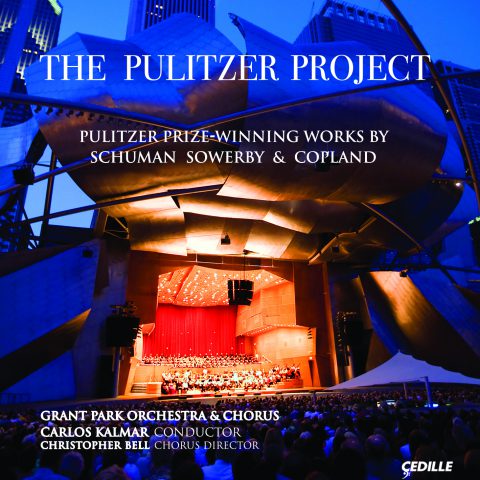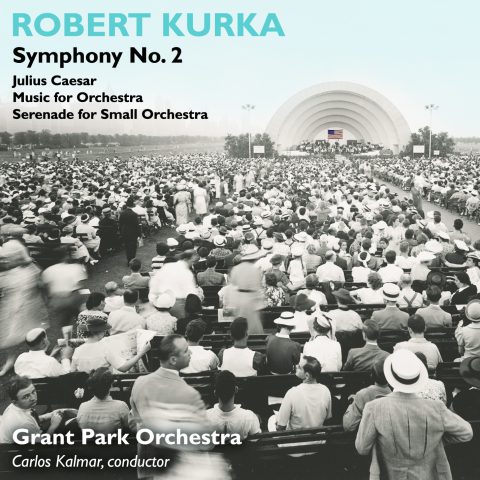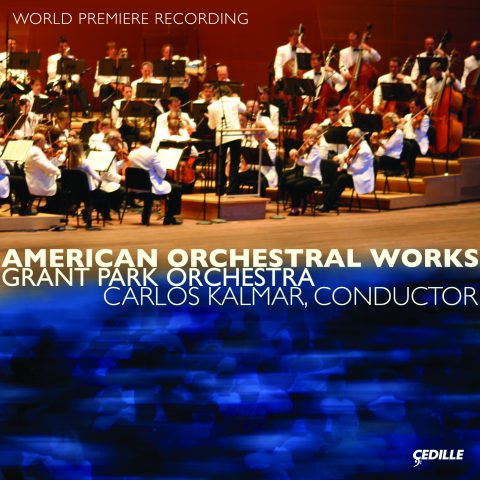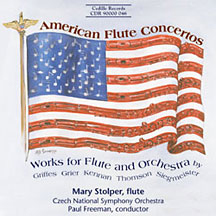Store
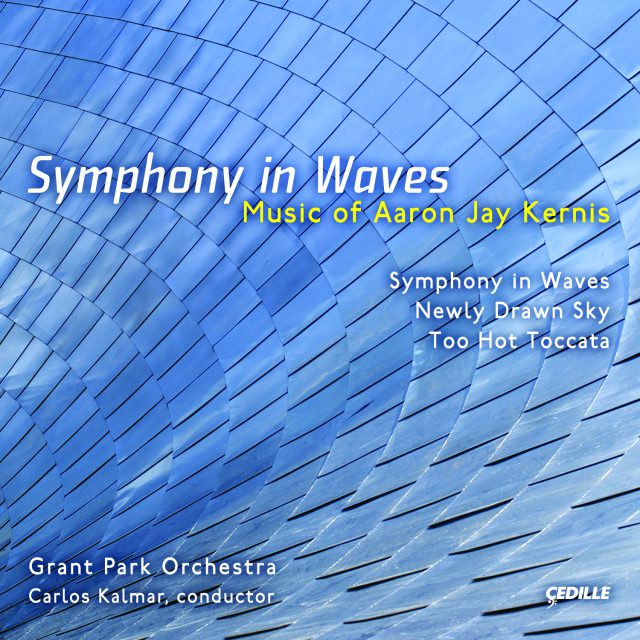
This offering from Carlos Kalmar and the acclaimed Grant Park Orchestra includes the first full-scale orchestral recording of Kernis’s Symphony in Waves (1989). Waveforms — wind and water, sound and light — are the undercurrents of this enchanting 40-minute spectacular of unusual sonorities and orchestral effects. The New York Times called it “remarkable,” the product of the composer’s “fearless originality and powerful voice.”
The CD also includes world-premiere recordings of Kernis’s soaring soundscape, Newly Drawn Sky (2005), and the hyper-energetic virtuoso orchestral showpiece Too Hot Toccata (1996).
It’s all captured in audiophile sound by Cedille Records, whose previous recordings of maestro Kalmar with the Grant Park and Chicago Symphony orchestras have been nominated for Grammy Awards in the “Best Engineered Classical Album” category.
Preview Excerpts
AARON JAY KERNIS (b. 1960)
Symphony in Waves
Artists
Program Notes
Download Album BookletSymphony in Waves
Notes by Andrea Lamoreaux
“A symphony must be like the world,” Gustav Mahler said to fellow composer Jean Sibelius in 1907. “It must contain everything.” Echoing this expansive view, Aaron Jay Kernis has said: “I want everything to be included in music: soaring melody, consonance, tension, dissonance, drive, relaxation, color, strong harmony and form — and for every possible emotion to be elicited actively by the passionate use of these elements.” Mahler would have approved, especially the part about passion, which in Kernis’s scores, as in those of the late-19th/early20th-century symphonic master, translates into open emotional expressiveness.
Kernis was born in Philadelphia in 1960, taught himself to play the piano, and began composing as a teenager. His subsequent composition teachers included John Adams at the San Francisco Conservatory; Charles Wuorinen at the Manhattan School of Music; and Jacob Druckman, Bernard Rands, and Morton Subotnick at Yale. In 1983, Zubin Mehta and the New York Philharmonic premiered his first symphonic score, Dream of the Morning Sky, to near-universal acclaim. Kernis later became one of the youngest composers ever to win a Pulitzer Prize, in 1998 for his second string quartet, subtitled Musica Instrumentalis, and the youngest American to be honored with a Grawemeyer Award, in 2002 for Colored Field.
The San Francisco Chronicle has commented: “With each new work and new recording, Kernis solidifies his position as the most important traditional-minded composer of his generation. Others may be exploring musical frontiers more restlessly, but no one else is writing music quite this vivid or powerfully direct.” In Chicago, Tribune music critic John Von Rhein found that “Kernis manipulates textures and complex, high-energy rhythms so cannily. . . . Symphony in Waves is music an audience can enjoy that doesn’t insult their intelligence.” The symphony is, in fact, a complicated score that requires copious rehearsal time, but it doesn’t sound particularly difficult; it comes across as an inevitable progression. The colorful and lively outer movements are set off by the capricious and playful tone of movements two and four, which are in turn strongly contrasted with the stark emotions of the centerpiece, titled “Still Movement.”
After composing professionally for 25 years, Kernis perceives three “personal genres” in his music. First, there are works that are essentially dramatic, combining consonance with chromaticism and dissonance, creating powerful statements through melodic and rhythmic evolution and contrasts of instrumental timbre. Symphony in Waves is such a work. He identifies the second genre as taking “a more meditative, calmer, and fundamentally melodic approach.” This is the basic nature of Newly Drawn Sky. Of his works that draw on the traditions of popular music and jazz (the third genre), Too Hot Toccata is a striking example, with echoes of bluegrass and honky-tonk, combined with perpetual-motion rhythmic propulsiveness.
About Symphony in Waves, Kernis says:
“Prior to writing this work in 1989 I never imagined I would write a symphony. It seemed such an outdated and irrelevant form. But in the early 1990s I became excited by the communicative potential and the highly varied ideas and emotions latent in traditional forms. I hoped to discover what “symphony” means to me, to define the form for myself, by bringing my own experiences and passions to it. Since that time I have written many works of symphonic scope, and at present am working on my Third Symphony for voices and orchestra.
“I was not dealing with waves in a strictly programmatic sense. I thought about waves of sound in addition to those of wind and water. Each movement uses some aspect of wave motion: swells and troughs of dynamics, densities, and instrumental color: the “sounds” of light broken into flickering bits by water’s action.”
In the first movement, “Continuous Wave,” the strings open with constantly-repeated patterns that represent one kind of wave. The use of repetition with slight changes is Kernis’ legacy from the minimalist school of Glass, Reich, and (sometimes) Adams. From the wave motives, a string solo emerges, first cello, then violin. A more rhythmic, pulsing section brings in the rest of the orchestra and intensifies the waves. A horn call repeats simple triadic patterns; the texture and sound change with the addition of scurrying woodwind motives: smaller, lighter waves. We hear more from the brass, and from the keyboard and the percussion players. The return of the earlier string theme signals a varied recapitulation: its lyrical sound is now surrounded by ongoing waves in the other sections of the orchestra. A big brass climax, more wave patterns in the strings, and a scale-like concluding theme that ascends from the lowest to the highest ranges of all the orchestra’s instruments: it dies away, and the “Continuous Wave” has ended.
The second movement, “Scherzo” opens with twinkling, chirping motives from soloists of the violin and viola sections, divided into several intertwining parts. The winds join in, the brass contributes a fanfare for contrast. The sound here is a strong contrast to that of the first movement: these sound waves are broken up, perhaps scattered by a strong wind. At first it seems that there are no distinctly recognizable themes, but as blues chords appear beneath solo cello and bass clarinet it gradually becomes clearer that the opening string fragments are being developed and riffed on. This passage is followed by a brass-and-winds interlude and a return of the opening string solo ideas placed in a new tonal context. The movement ends in a sudden blaze of honkytonk.
Kernis has described “Still Movement” the symphony’s central and longest portion, as a cresting tidal wave, but it is one that seems to be in terrifyingly suspended animation. A fearful catastrophe is impending. The huge instrumental scream that opens the movement could also be construed as the threat of a flooding river, a tornado sighted on the horizon, a hurricane hurtling up the coastline. Chimes pound in the background of winds and strings playing in their high registers. The fortissimo stasis of this sustained sound is broken by a blast from the brass, followed by a string solo, mournful and wandering. The strings then have an echo of their main theme from the first movement; it sounds more ominous now, intense and slow-moving. The winds and bells pick the theme up, then we hear it from a solo bassoon. Changing the mood almost entirely is the ensuing flute solo, a kind of cadenza that provides an interlude of serenity: perhaps this is the eye of the hurricane. The mood and theme are picked up by the strings, but a huge roar leads us to a recapitulation, and to a return of the movement’s opening terror, with the orchestra virtually in unison, punctuated by crashing percussion. It would seem the eye of the hurricane has passed over, and the storm has turned back upon us. Ascending motives in the brass, drum rolls, deep tones from the chimes – then the strings end the movement softly.
The very brief fourth movement, “Intermezzo” gives a sense of calm after the storm. Descending, diatonic string melodies offer sunshine, with sparkles from the woodwinds. It’s as though we’re hearing waves of light. Agitation returns at the start of the Finale, with disjointed motives that recall the texture of the second movement. Trumpet and strings are prominent and engage in bizarre, jazzy dialogues. A fanfare of repeated notes from the brasses leads to a more lyrical theme that emerges in the strings, who soon switch to pizzicato playing to build up to another brass fanfare. An ascending theme, shared by the full orchestra, builds up sheer waves of sound. This is followed by a big climax, short scattered motives for winds and strings, some assertive outbursts, a constantly-repeated three-note motive, and the sudden punch of the final chords.
Symphony in Waves is about waves of various kinds, but it’s also about pure sound – a master craftsman is exploiting all the possibilities of the modern symphony orchestra.
Newly Drawn Sky was commissioned by Welz Kauffman and the Ravinia Festival to celebrate James Conlon’s first season as the festival’s music director, the summer of 2005. Located in Chicago’s northern suburbs, Ravinia is the summer home of the Chicago Symphony. The spacious park, with lawn and pavilion seating, is filled with trees and illuminated by the summer moon and stars (in addition to man-made lighting for convenience and safety). Millennium Park, home of the Grant Park Music Festival and the Grant Park Orchestra, is located in downtown Chicago, with Lake Shore Drive on one side and high-rise office buildings on the other. Concert-goers at the admission-free festival sit on the Great Lawn or inside the open-air shelter of the Jay Pritzker Pavilion. Look to the east and see the moon and stars of a summer night shining over Lake Michigan. Look westward, and there’s the Chicago skyline with its array of electric lights. Writing to introduce the first (and so far only other) recording of Symphony in Waves, Mark Swed noted how Kernis’ music “finds surprising room for both restless urban energy and rapturous contemplation.” In Newly Drawn Sky, inspired by a twilight walk on a Long Island beach, Kernis has created a work that seems expressly designed to be heard in an outdoor setting, one that combines a city atmosphere with the sights and sounds of nature. A drawn-out summer sunset mingles with city lights as darkness slowly falls.
“Newly Drawn Sky,” Kernis says, “is a lyrical, reflective piece for orchestra, a reminiscence of the first summer night by the ocean spent with my young twins (who were six months old when the work’s initial inspiration came to me), and the changing colors of the summer sky at dusk. While the work is not programmatic or specifically descriptive, it reflects a constancy of change and flux musically and personally.” He also said: “There are some transformational aspects from which the musical material was developed. The middle of the piece is very relaxed and very lyrical, like summer evening music. About two-thirds of the way through, there’s a big buildup of wind sound in the percussion section of the orchestra — it sounds very much like an echo of nature.”
Kernis further notes that Newly Drawn Sky was influenced by the technique of constantly-transforming melody that characterizes the orchestral music of Sibelius. “Melodically, it includes a basic element of much of my work, a rapturous embrace of long lines and lyrical melodies. Newly Drawn Sky continues my approach to melody that I’ve used in works like the Sarabanda, Musica Celestis, and the Second Symphony. The piece is consistent with many works I’ve written over the past seven years, unified by a use of narrative and development of melodies and motives.”
The cello theme that was prominent in the first movement of Symphony in Waves is echoed at the start of Newly Drawn Sky by another rising cello line. For this and other themes that steadily emerge and evolve throughout the piece, Kernis uses three-note chords as harmonic underpinning: chords that continually, subtly shift. With all the shifts and evolutions, however, there’s still a sense of calm serenity created by the ongoing intertwining of themes.
Some urban jazziness develops, leading to a bursting climax of brilliant sound, then the serene atmosphere returns, with high winds and strings and then a trumpet solo. A wandering string melody emerges, evocative of the quiet beauty of night. Then lively wind motives provide a brightening atmosphere, leading to another string melody and a full orchestral climax with percussion and horns. The instruments of the full orchestra celebrate with a shimmering, light-filled, ascending melody to bring Newly Drawn Sky to an end.
Kernis wrote Too Hot Toccata in 1996:
“I considered [it] to be a kind of farewell to my St Paul Chamber Orchestra residency, but not as a farewell to the orchestra. This work features just about all of the principal players and treats all of the various orchestra sections as soloists. There is also a horribly difficult honky-tonk piano solo, as well as a fiendish clarinet solo and a big part for the piccolo trumpet, in addition to a lot of virtuoso percussion writing. The music is a little hyperactive, very high energy and quite out of control, but with a slower middle section for balance.”
Bela Bartok’s Concerto for Orchestra took the idea of the solo concerto, wherein one player displays his virtuosity in contrast to an orchestral background, and expanded it to feature each section of the orchestra as virtuoso soloists. Witold Lutoslawski also wrote a Concerto for Orchestra, and The Young Person’s Guide to the Orchestra, by Benjamin Britten, likewise spotlights each symphonic section in soloistic passages. With Too Hot Toccata, Kernis has added a short, vivid, fun-loving work to this distinguished canon. A lively theme in the winds and brass opens up the toccata, then the strings pick up the theme and dance with it. The progression is virtually perpetual-motion, but it moves forward with a great deal of syncopation and numerous incisive accents from the percussion. Each section does indeed get to show off its skills. A string solo passage introduces a calmer note, quickly succeeded by a passage in swing style featuring keyboard. Then we return to the compulsive rhythmic patterns on the opening, and brass and percussion add a jazzy note. By this time the audience’s feet are tapping along with each new beat. A big trumpet riff brings Too Hot Toccata to a close.
In addition to the three works recorded here, performed during the summers of 2006 and 2007, Carlos Kalmar and the Grant Park Orchestra have also recorded Kernis’s Sarabanda in Memoriam, dedicated to the victims of September 11, 2001, on American Orchestral Works, Cedille Records CDR 90000 090.
Andrea Lamoreaux is music director of 98.7 WFMT, Chicago’s classical experience.
About Aaron Jay Kernis
Aaron Jay Kernis, winner of the coveted 2002 Grawemeyer Award for Music Composition and one of the youngest composers ever awarded the Pulitzer Prize, is among the most esteemed musical figures of his generation. His music figures prominently on orchestral, chamber, and recital programs around the world. He has been commissioned by many of America’s foremost performing artists, including sopranos Renee Fleming and Dawn Upshaw, violinists Joshua Bell, Nadia Salerno-Sonnenberg, and James Ehnes, and guitarist Sharon Isbin, and by institutions including the New York Philharmonic, San Francisco Symphony, Birmingham Bach Choir, San Francisco Conservatory, Minnesota Orchestra, and Los Angeles and Saint Paul Chamber Orchestras, the Ravinia Festival, the Walt Disney Company, Chamber Music Society of Lincoln Center, and the Rose Center for Earth and Space at the Museum of Natural History in New York, among many others. Upcoming are new works for trumpet soloist Philip Smith with the New York Philharmonic and a consortium of “Big 10” college wind ensembles, the Seattle Symphony, and the Orpheus Chamber Orchestra. Recent recordings include a disc of his song cycles by soprano Susan Narucki (Koch) and Goblin Market, a major dramatic work (Signum Records). His music is also available on Nonesuch, Phoenix, New Albion, Argo, and Cedille.
Mr. Kernis garnered his Grawemeyer Award for his cello concerto “Colored Field” and the 1998 Pulitzer Prize for his String Quartet No. 2 (“musica instrumentalis”). He has also received the Stoeger Prize from the Chamber Music Society of Lincoln Center, a Guggenheim Fellowship, the Rome Prize, an NEA grant, a Bearns Prize, a New York Foundation for the Arts Award, Grammy Award nominations for both “Air” for violin and orchestra and his Second Symphony, and the BMI Foundation’s “Outstanding Musical Citizen Award” for his work as Co-Director of the Minnesota Orchestra Composer Institute.
Kernis has become an especially familiar and admired presence in Minnesota’s Twin Cities: In September 1993, he was appointed Composer-in-Residence for the St. Paul Chamber Orchestra, Minnesota Public Radio, and the American Composers Forum. He returned in fall 1998 as New Music Advisor to the Minnesota Orchestra, a position he retains to this day. He is chairman and co-director of the Minnesota Orchestra Composer Institute, a program that gives young composers the opportunity to hear their works played by a major orchestra. Since 2003, he has taught composition at the Yale School of Music.
Aaron Jay Kernis was born in Philadelphia on January 15, 1960. He began his musical studies on the violin; at age 12 he began teaching himself piano and, the following year, composition. He continued his studies at the San Francisco Conservatory and the Manhattan and Yale Schools of Music, working with composers as diverse as John Adams, Charles Wuorinen, and Jacob Druckman. Kernis first came to national attention in 1982 with the acclaimed premiere of his first orchestral work, Dream of the Morning Sky, by the New York Philharmonic at its Horizons Festival. Mr. Kernis’ music is published and represented by Associated Music Publishers (www.schirmer.com).
Album Details
Total Time: 64:00
*World Premiere Recording(s)
Producer: James Ginsburg
Engineers: Chris Willis, Bill Maylone (Symphony in Waves); Eric Arunas, Bill Maylone (Newly Drawn Sky, Too Hot Toccata)
Digital Editing: Bill Maylone
Graphic Design: Melanie Germond
Cover Photo: Detail of the BP Pedestrian Bridge in Millennium Park, Chicago © Tom Van Eynde
Recorded in concert in Orchestra Hall, Chicago, August 4 & 5, 2006 (Symphony in Waves), and at the Harris Theater for Music and Dance in Millenium Park, Chicago, June 29 & 30, 2007 (Newly Drawn Sky, Too Hot Toccata)
Publishers:
AJK Music ©2005 (Newly Drawn Sky)
Associated Music Publishers, Inc. ©1996 (Too Hot Toccata)
©1989 (Symphony in Waves)
© 2008 Cedille Records/Cedille Chicago
CDR 90000 105
